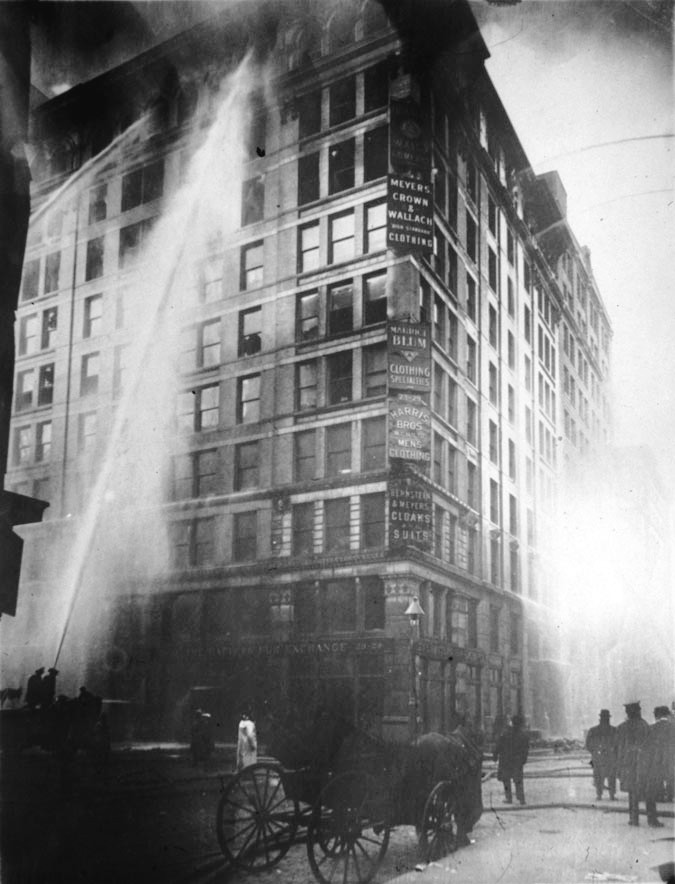It was March 25, 1911, in New York City. It was a Saturday afternoon just like any other at the Triangle Shirtwaist factory, where young immigrant women sat in front of sewing machines, day in and day out, sewing. But on that day a fire broke out, causing the deaths of 146 garment workers. Among those who died in the flames and smoke were 123 women and 23 men.1 Many even jumped or fell to their deaths out the windows, making this event a man-made disaster and one of the deadliest industrial disasters of all time.

The factory was located in the Asch Building at Washington Place in Greenwich Village, one of the wealthiest neighborhoods in the city. The factory occupied the eighth, ninth, and tenth floors of the ten-story building. Max Blanck and Issac Harris were the owners of the factory, and their company was known as the largest firm in the business at the time. They styled women’s blouses known as “Shirtwaists,” which were paired with tailored skirts. This attire had become the standard in fashion for women in the early twentieth century. They were also known to resemble men’s shirts. When it came to their workers, they had hired operators who then contracted out for factory workers. The company itself only dealt with the contractors, and there was no fixed rate of pay for the workers.2 At the time, the factory employed about five-hundred employees, mostly young immigrant women who were of Italian or Jewish descent. These women worked up to eleven-hour shifts on weekdays, and twelve-hour shifts on Saturdays, and they earned between $7-$12 dollars for a 52-hour week. Many of these women were the breadwinners of their household, and their income was sometimes not sufficient to cover their needs.
Towards the end of the workday on that Saturday evening in 1911, a fire broke out around 4:00 pm. The fire started in a scrap bin under one of the cutter’s tables on the eighth floor from what is believed to have come from a cigarette. A manager tried to put the fire out with a hose but the hoses valve was rusted shut, and rotten away. The fire spread quickly and the workers panicked. There was one fire escape that quickly collapsed, and four elevators, which out of the four only one was working. The elevator held twelve people at a time, and it managed to make four rescue trips before it broke down.3 With no other alternatives available, people began throwing themselves out the windows, and some were even crushed to death trying to get out. Workers tried to take the stairs, but the exit doors only opened inward and were kept locked by factory management to prevent theft by the workers, as the managers would check their workers belongings every day before they left for the day.

Celia Saltz Pollack, a survivor of the 1911 Triangle Shirtwaist Fire said,
I remember on that day there was a lot of singing and happiness in the shop because it was the end of the week and we got paid. We were soon all going to go home. When the fire started I was sitting at my machine. I looked up and saw the fire near the cutting tables but I did not think it was so terrible. What was terrible was that the fire spread in a split second.
By the time the firefighters arrived, they came to the realization that their ladders could only extend up to the sixth or seventh floors. With no other option, sixty-two workers jumped and fell to their deaths, while the remaining died from the smoke and flames within the building.4

This fire not only pushed issues of unsafe factories and immigrant exploitation into the public consciousness, but for the first time the fire allowed for attention to be brought to deplorable conditions of New York factories.5 Women obtained well deserved attention onto current work conditions and safety measures in the workplace. Although the Triangle Shirtwaist Factory fire brought a feeling of resentment and heartbreak to many, this event and its victims will always be remembered.
- Ric Burns, “Triangle Shirtwaist Fire,” New York Times (1923-Current File), Nov 24, 1999. ↵
- Jonathan Fink, “Conflagration and Wage: The Triangle Shirtwaist Factory Fire, 1911,” TriQuarterly, no, (2009): 135-136. ↵
- Gale Encyclopedia of U.S. Economic History, s.v. “Triangle Shirtwaist Fire,” by Thomas Carson and Mary Bonk. ↵
- Mia Lynn Mercurio, Régine Randall, “Tributes Beyond Words: Art Educators’ Use of Textiles to Memorialize the Triangle Shirtwaist Factory Fire.” Journal for Learning through the Arts no. 1 (2016): 4-5. ↵
- Albert Marrin, Flesh and blood so cheap: The Triangle fire and its legacy (New York: Alfred A. Knopf, 2011), 23-25. ↵



135 comments
Andrea Chavez
This was a very interesting topic, the form of writing is so smooth to read and it is easy to be interested in it. It is truly horrible the high amount of deaths and more than that the way of their deaths. I think the factory should have paid the woman there, but I also get that those were different time.
Edward Cerna
This was a very well written article. I like the way you organized it because you did it very well. I have never heard of this ever and it is truly sad what happened that day. 123 women and 23 men perished that day and even jumped out the building. That part really made me sad because of the image it put into my head.
Sebastian Castro Ramos
What a sad story. It is terrible that it was until this event happened that consciousness about safety on the workplace and working conditions in factories arose. It was terrible that the doors to the stairs were locked, only one of the four elevators worked and only fire escape collapsed. This event also may have had some effect on the fire department in the reconsideration of their equipment, since they could’t reach the factory with their ladders.
Tyler Bradford
It is truly sad and unfortunate that this event happened, but it’s even more sickening to know that in order for people to realize that the working conditions were beyond horrible, a fire had to break out and be the cause of many deaths. Keeping workers locked inside a building in general is wrong and then to basically force them to work, treating them as if they were slaves is inhumane. However, had this tragic incident not occur, we may not have the rules and regulations that ensure our health and safety today.
Joel Gracia
This is an awful event in history and, due to the good quality of the article, it was painful to read about. The lack of preparation for a disaster such as this seems ridiculous now, but I am sure that nobody was considering something such as this happening when it had never occurred before. In the end, although it was a terrible loss, it seems that all precautionary inventions like fire escapes and such are invented only after it is proven that they are needed.
Mariah Cavanaugh
The men and women who lost their lives in the Triangle Shirtwaist fire should be revered as heroes. They suffered through a horrific death but out of their deaths came change. It’s a shame that it took a tragedy for change to be enacted, but that seems to be how it usually goes. Your story was interesting, well written and well researched. I loved the pictures you chose to accompany your article. They added a visually powerful message to accompany the sadness within your article.
Mark Martinez
A perfectly written and well put together article that kept we wanting to read more. I will never understand how something terrible always needs to happen for people to realize something needs to be changed. These poor women worked hard all week and were even in a good mood because the work day was almost over. This tragedy could have been avoided if the company had taken the time to do maintenance on things that were obviously broken. When there is enough rust to make something fall apart it is not exactly hiding from the naked eye.
Alexis Renteria
Its sad how an event as tragic as this had to happen in order to bring attention to the working conditions in factories back in the 1900s. It sucks how only one of the four elevators worked and the other escape exits collapsed before they could get people out of the building. The fact that people were jumping out of the windows just to fall to their deaths shows the fear of the workers going through such a terrifying event. Overall, this article does a great job of showing how bad the working conditions were and how immigrant workers were being treated at the time, and what it took to bring awareness to the issue.
Alondra Aviles
It’s a very tragic event that impacted our current society. Although very sad and unfortunate for all the lives lost, many people working labor are now much safer and have more regulations to properly do their job without causing a catastrophic event, much like the fire. In my opinion, I believe that there is more that can be implemented in the work force to ensure absolute safety but I know that there are sufficient regulations in certain areas. What is very astonishing is the wage to hour ratio during that time and how much immigrants were taken advantage of.
Zeresh Haman
This is such a sad story, its truly awful to think about what the workers trapped inside went through before they died. I can’t believe that out of four elevators only one was working, and the one that was working only held 12 people. I think its unfortunate that it took something as terrible as this to make people to really notice how bad the working conditions were in these factories. Really great article about a really sad story.